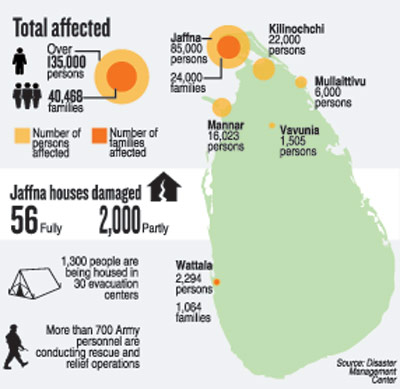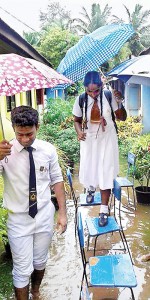News
Incessant rains lead to floods, thousands homeless
Incessant rains followed by flooding left thousands of people displaced and affected in many parts of the island, including the Northern Province which was earlier hit by dry weather.

Flooded out: A scene from Dambulla. Pic by Kanchana Kumara Ariyadasa
Over 124,000 people belonging to 35,795 families have been affected by flashfloods, Disaster Management Centre (DMC) sources said.
Over 2,000 persons in the Wattala grama niladhari division belonging to 1,064 families have been affected by floods.
DMC Deputy Director Pradeep Kodipilli said 23,000 individuals have been affected by floods in Kilinochchi while 6952, 16,023 and 1505 persons in Mullaitivu, Mannar and Vavuniya Districts, respectively, have been similarly affected.
Jaffna DMC regional office Assistant Director Sangarapillai Ravi said over 73,000 individuals from 20, 000 families in the Jaffna District have been affected. 156 houses have been fully damaged while more than 2,000 houses were partly damaged.
“Sixty two relief centres were set up for those affected by floods but with the rains lessening, 32 centres have been dismantled. 1,300 people are being housed in the shelters,” he said.
“Steps are being taken to create a better drainage system for the flood waters to be diverted in future,” Mr. Sangarapillai added.
Navanthurai, Vasanthapuram, Sooriyaveli, Nithayoli, Navatkuli and Vellanai-Sinnamadu are the places in the Jaffna peninsula most affected by floods.
The increase in population and subsequent need for land have forced more and more people to live and work in the vulnerable areas, thereby intensifying the risk to life and property in the event of a major flood, DMC Director General L.B.R Mark said.
“Heavy rainfall and the large volume of water from the catchment areas of rivers, deforestation, improper land use and the absence of scientific soil conservation practices could be identified as the major factors for floods in Sri Lanka,” he said.
Urbanisation with insufficient infrastructure facilities such as drainage systems trigger urban flash floods in addition to global phenomena like climate change which increase rainfall intensities, he said.
“Kilinochchi District shows a higher flood susceptibility due to cyclonic storms. Even though the annual rainfall is lower than in the western highlands, Vavuniya and Mullaitivu Districts in the north have recorded the highest rainfall intensities in the island,” he said.
He referred to the occurrence of landslides, excessive rainfall, deforestation and unplanned land use practices, especially within the last two decades, on the mountain slopes of the central and south western regions of the island.
More than 700 Army personnel are conducting rescue and relief operations in the flood-hit Kilinochchi, Mullaitivu and Wanni Districts. Nearly 5,000 people in Palliyaru, Vannikulam, Mandagalaru, Pannagandi and Netahaliyaru areas are affected, Army Media Spokesperson Brigadier Janath Jayaweera said.

Chillaw: Schoolchildren use a makeshift ‘chair -bridge’ to get from one point to another in their school premises. Pic by Augustin Fernando
They have also been provided basic amenities such as drinking water, soap, mats and pillows. Most of their houses have been submerged.
Army personnel distributed food packets to the victims, although some of them had by then moved into the houses of their close relatives.
Troops also provided assistance by providing transport to the Kilinochchi district hospital. Meanwhile, troops responding to the looming flood threats, evacuated many affected people and provided them shelter at the Kallapadu Primary Vidyalayam, Pandarawani Church and Muthiyankattu Vidyalayam, Brigadier Jayaweera added.
Kilinochchi District Secretary S. Arumainayagam, said the affected people are now being provided with dry rations and cooking utensils with more than 300 Army personnel assisting.
Meanwhile, troops in Killinochchi have put up additional toilets in places for the displaced and also made their gully bowsers available for collection of sewage.
Sri Lanka Red Cross Society (SLRCS) Media Spokesperson Mahieash Jonny said the SLRCS is responding to emergencies as a result of adverse weather conditions. Its branch network has been providing relief and humanitarian support from the onset of the emergency, he said.
“SLRCS has been assisting in evacuation, in coordination with Government authorities, to ensure people affected are brought to safety. Over 86,000 people living in nine divisional secretariat areas are affected,” he said.
The Red Cross distributed tarpaulins, hygiene kits and bed sheets. Our volunteers also assisted in distribution of cooked food and milk powder to the people housed in the camps, he said.
The regional offices of SLRCS in Kilinochchi and Mullativu provided non-relief items and also supported in evacuating those affected by the disaster.
Assessments are being carried out on the damage to houses within the district and to ensure the safety of the people when they move back to their residences, he said.
In Puttalam, Nuwara Eliya, Kandy, Gampaha, Vavuniya, Galle, Kegalle, Anuradhapura, Matale and Mannar Districts, SLRCS branches deployed disaster response teams to assess the conditions and to obtain accurate information as to how many people are affected by the floods.
Meteorology Department duty forecaster Nimal Bandara said the depression formed in the Bay of Bengal has triggered heavy rains in Sri Lanka as well as in India.
Under the influence of the system, showery weather and cloudy skies over the country are expected to continue today.
“The possibility of strong winds over the country and the surrounding sea area is still high,” he said.
Showers or thundershowers will be experienced over most parts of the island, particularly in the northern half of the island. Very heavy falls (above 150 mm) are also likely in some places.
| Northern students given lessons on flood safetyStudents in the Northern Province were facing many hardships due to floods, Jaffna’s Additional District Secretary Senthil Nanthan said.Some schools that were affected in Vadamarachchi East were shut down early this week. “We instructed the school principals and the zonal education officers to shift the students to a safe place till the water receded. We also informed the principals to educate the students about taking precautions during a flood situation,” he said. He said the programme included, analysing the specific vulnerability, hazards in the school environment, mapping out the village and school premises with evacuation routes and mock drills. He said the programme would prepare the school community to face any emergency situation during floods. Mullaitivu Government Agent R. Ketheeswaram said none of the schools in the district was closed. Pointing out that Sri Lankan schoolchildren were vulnerable to such weather hazards she said it was important for schools to develop school disaster contingency plans. “Our objective is to provide maximum protection to each of our students and the school community and to prevent possible harm and damage that could occur during and after a disaster,” she said. ‘In the recent past, flooding has become more severe. Flood waters pose serious health issues among the people,” Ms. Ketheeswaram said. “Because of the irregular collection of garbage, residents dispose of their rubbish in trenches and on the streets. These end up in drains and cause blockages. We also need to educate students about the health consequences of dumping rubbish on the roads,” the GA added. Meanwhile Kilinochchi Education Zonal Social Science advisor Poobalasingam Thirukumar said out of the 104 schools in Kilinochchi district ten had been affected by floods but none was shut down. “We were educating the students about their health hazards. Flood waters present a serious threat to personal health, and children are particularly at risk. These waters contain disease causing microorganism, dirt, oil, human and animal waste and farm and industrial chemicals,” he said. Direct and indirect contact with the contaminants – whether through direct food intakes, vector insects such as flies, unclean hands, or dirty plates and utensils – could result in waterborne diseases and life-threatening infectious diseases, he explained. |

